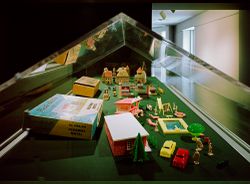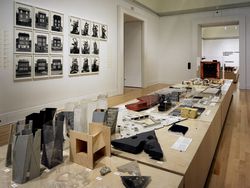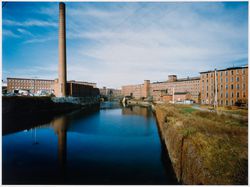The Anatomy of the Architectural Book, an exhibition presented in conjunction with the publication of a book of the same title by André Tavares, examines the relationships between book culture and building culture, making visible the axes along which architectural knowledge circulates through books into buildings and back. Through seven themes—Texture, Spread, Sequence,(...)
10 May 2016 to 20 November 2016
The Anatomy of the Architectural Book
Actions:
Description:
The Anatomy of the Architectural Book, an exhibition presented in conjunction with the publication of a book of the same title by André Tavares, examines the relationships between book culture and building culture, making visible the axes along which architectural knowledge circulates through books into buildings and back. Through seven themes—Texture, Spread, Sequence,(...)
The exhibition Robert Burley: The Disappearance of Darkness presents a series of photographs by Canadian artist Robert Burley, documenting the decline of traditional photographic equipment manufacturing brought on by new technologies. Since 2005, digital photographic technology has increasingly displaced its analog predecessor, resulting in a plummeting demand for(...)
Hall cases
11 September 2009 to 15 November 2009
Robert Burley: The Disappearance of Darkness
Actions:
Description:
The exhibition Robert Burley: The Disappearance of Darkness presents a series of photographs by Canadian artist Robert Burley, documenting the decline of traditional photographic equipment manufacturing brought on by new technologies. Since 2005, digital photographic technology has increasingly displaced its analog predecessor, resulting in a plummeting demand for(...)
Hall cases
The armies of World War Two represented only the tips of colliding icebergs, the belligerent nations which had mobilized and transformed themselves for a global “war of production” of unprecedented scale. Architecture in Uniform: Designing and Building for the Second World War documents the extensive contribution of architecture to the war between the bombings of Guernica(...)
Main galleries
13 April 2011 to 18 September 2011
Architecture in Uniform: Designing and Building for the Second World War
Actions:
Description:
The armies of World War Two represented only the tips of colliding icebergs, the belligerent nations which had mobilized and transformed themselves for a global “war of production” of unprecedented scale. Architecture in Uniform: Designing and Building for the Second World War documents the extensive contribution of architecture to the war between the bombings of Guernica(...)
Main galleries
Not only do toys provide evidence of the social and economic life of their period, but architectural toys ranging from wooden building blocks to iron and steel construction sets reflect distinct stylistic predilections and technological advances. New industrial and building techniques were used not only to create the new building types transforming our cities, but were(...)
Octagonal gallery
28 November 1990 to 31 March 1991
Buildings in Boxes: Architectural Toys from the CCA
Actions:
Description:
Not only do toys provide evidence of the social and economic life of their period, but architectural toys ranging from wooden building blocks to iron and steel construction sets reflect distinct stylistic predilections and technological advances. New industrial and building techniques were used not only to create the new building types transforming our cities, but were(...)
Octagonal gallery
Myron Goldsmith’s architectural works show how an economy of means and a modest approach can generate a profoundly poetic expression. Myron Goldsmith: Poet of Structure reveals how the architect’s methods and ideas are formed, developed, and disseminated by drawing upon the body of notes, sketchbooks, and study documents found in the collection of Goldsmith’s personal(...)
Main galleries
13 March 1991 to 2 June 1991
Myron Goldsmith: Poet of Structure
Actions:
Description:
Myron Goldsmith’s architectural works show how an economy of means and a modest approach can generate a profoundly poetic expression. Myron Goldsmith: Poet of Structure reveals how the architect’s methods and ideas are formed, developed, and disseminated by drawing upon the body of notes, sketchbooks, and study documents found in the collection of Goldsmith’s personal(...)
Main galleries
Herzog de Meuron: Archaeology of the Mind presents an exhaustive display of materials from the architects’ archive and from related collections. Referencing a natural history, the exhibition includes study models, books, photographs, toys, fossils, Chinese scholars’ rocks, and significant works of contemporary art, all of which have informed the thinking of the Swiss(...)
Main galleries
23 October 2002 to 6 April 2003
Herzog & de Meuron: Archaeology of the Mind
Actions:
Description:
Herzog de Meuron: Archaeology of the Mind presents an exhaustive display of materials from the architects’ archive and from related collections. Referencing a natural history, the exhibition includes study models, books, photographs, toys, fossils, Chinese scholars’ rocks, and significant works of contemporary art, all of which have informed the thinking of the Swiss(...)
Main galleries
The 60s: Montréal Thinks Big
During the 1960s, the massive scale of the changes that transformed Montréal made it an archetype of the great metropolises of the Western world. As host of Expo 67, Montréal asserted itself on the international scene as a city of the future. The 60s: Montréal Thinks Big illustrates the processes that brought about these changes. The exhibition’s original models,(...)
Main galleries
20 October 2004 to 11 September 2005
The 60s: Montréal Thinks Big
Actions:
Description:
During the 1960s, the massive scale of the changes that transformed Montréal made it an archetype of the great metropolises of the Western world. As host of Expo 67, Montréal asserted itself on the international scene as a city of the future. The 60s: Montréal Thinks Big illustrates the processes that brought about these changes. The exhibition’s original models,(...)
Main galleries
Commissioned by the CCA, for three years, French photographer Serge Hambourg recorded over four hundred historic mills and factories throughout New England. By capturing their surroundings as well as by focusing on the stark beauty of their interiors and exteriors, the images trace the evolution of this building type. The photographs included in the exhibition range from(...)
Octagonal gallery ante-room
6 December 1989 to 11 February 1990
Mills and Factories of New England: Photographs by Serge Hambourg
Actions:
Description:
Commissioned by the CCA, for three years, French photographer Serge Hambourg recorded over four hundred historic mills and factories throughout New England. By capturing their surroundings as well as by focusing on the stark beauty of their interiors and exteriors, the images trace the evolution of this building type. The photographs included in the exhibition range from(...)
Octagonal gallery ante-room
Parables and Other Allegories: The Work of Melvin Charney 1975–1990 comprises approximately 100 drawings, including many large-scale, sketches, photographs, and three large constructions. By assembling works from various public and private collections, including the CCA, the exhibition permits a comprehensive analysis of Charney’s artistic process to reveal the dialogue(...)
Main galleries
9 October 1991 to 12 January 1992
Parables and Other Allegories: The Work of Melvin Charney, 1975-1990
Actions:
Description:
Parables and Other Allegories: The Work of Melvin Charney 1975–1990 comprises approximately 100 drawings, including many large-scale, sketches, photographs, and three large constructions. By assembling works from various public and private collections, including the CCA, the exhibition permits a comprehensive analysis of Charney’s artistic process to reveal the dialogue(...)
Main galleries
Wohnhaus Schlesisches Tor—also known as Bonjour Tristesse—in Berlin and Punt en Komma in The Hague are Álvaro Siza’s first built works outside his native Portugal. The two projects resemble one another in size, scale, program, and ambition: both were built in the 1980s, both are results of a distinct attitude towards the city, and both were social housing projects(...)
Octagonal gallery Keyword(s):
Álvaro Siza, Punt en Komma, The Hague, Bonjour Tristesse, Berlin
24 September 2015 to 22 May 2016
Corner, Block, Neighbourhood, Cities. Álvaro Siza in Berlin and The Hague
Actions:
Description:
Wohnhaus Schlesisches Tor—also known as Bonjour Tristesse—in Berlin and Punt en Komma in The Hague are Álvaro Siza’s first built works outside his native Portugal. The two projects resemble one another in size, scale, program, and ambition: both were built in the 1980s, both are results of a distinct attitude towards the city, and both were social housing projects(...)
Octagonal gallery Keyword(s):
Álvaro Siza, Punt en Komma, The Hague, Bonjour Tristesse, Berlin









